February 11, 1999
Game One
White: Allen Starfy
Black: Ty Davison
Opening: B07 Pirc, 150 A
E-mail, Game 1, 1997
1. e4 d6
Al: Arrrggghh...the Pirc. This is where I break out the books and check the various lines so I can devise a plan of attack.
2. d4 Nf6
3. Nc3
Al: Thought about d5 at this time to head off Black's setting up his pawns correctly but decided against it as it would end up leaving me nothing in the center and very open to a quick attack.
3. ... g6
4. Be3 Bg7
5. Qd2
Al: Moving my Queen so I can castle Q-side. Plan later to use the H-file.
5. ... c6
6. Nf3 e6
7. Bd3 0-0
Ty: Up to here, both positions look solid. White has a myriad of options available while Black has castled, is well-defended and has a fianchettoed Bishop.
8. 0-0?!
Ty: Al, you later remarked on this Kingside castle as a mistake. Though I sure didn't see it at the time, I see what you mean now: Playing 0-0-0 would've made White very strong on the d-file.
Al: A terrible blunder; I castled out of habit. This is going to cost me time and unnecessary moves.
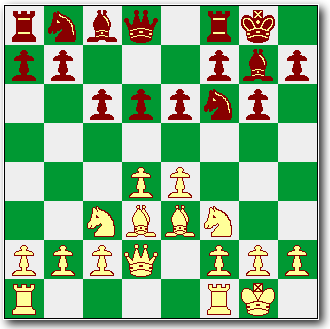
8. ...b5
Ty: At this point I recall having little to no idea of how to begin attacking the fortress Al had constructed. I wasn't about to storm the middle, so I figured an end-run was the least risky alternative.
9. d5
Al: My reasoning behind this is to double the pawns on the d-file and give me a little elbow room.
9. ... cxd5
10. exd5 exd5
11. Nxb5
Ty: The bloodbath in the middle ends even in material, and Black's pawns are doubled on the d-file. In consolation, Black now has the initiative. He needs it.
11. ... Ng4
Ty: This was my attempt to either trade for the Bishop on e3 or force some movement by the pawns blockading the King or both...
12. Bxa7
Ty: ...so boy was this unexpected. The best I could come up with was a similar Bishop attack with
12. ... Bxb2
Ty: This had the delightful advantage of pressuring the Rook on a1 (for which I would have gladly traded my Horsey on b8).
13. Rab1
Ty: White both protects his Rook and threatens the Bishop. The obvious response of Rxa7 is discarded in favor of
13. ...Nc6
Ty: ...since Black's Rxa7 leads to Nxa7 and a decided disadvantage.
14. Rxb2 Nxa7
Ty: There go the hapless Bishops.
15. h3?
Ty: I think this was a mistake, plain and simple. The Knight on g4, while applying some pressure, isn't in an overwhelmingly threatening position and now pawn log-jam in front of the King has begun to move.
Al: Probably a mistake; I'm still trying to figure out how to use the h-file without it taking up a lot of moves.
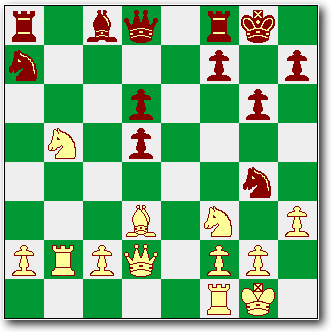
15. ... Ne5
Ty: White's got a tough choice here. If he plays Nxe5, then Black's central pawns are undoubled through exe5.
16. Nxa7
Ty: White finally puts the long-suffering Horsey on a7 out of its misery. One might anticipate an immediate Rxa7, but there's no hurry because
16. ... Nxf3+!
Ty: ...is one of the most brilliant moves I've ever had the good fortune to stumble upon. It's a straight trade in terms of material, but White is forced to double his pawns, and ooh boy does that King look tempting with an unprotected g-file in front of him.
Al: A great move and one I wasn't expecting.
17. gxf3 Rxa7
Ty: And so all the Knights go to Horsey Heaven.
18. Qh6
Al: A planned move but, in hindsight, premature.
Ty: I'm still undecided about the merits of this attack. It definitely applies pressure to the King, but the Queen is in a most isolated position. Nonetheless, it does provide some g-file cover which is critical.
18. ... Qf6
19. Rb4 d4
Ty: It doesn't take a genius to see where White's Rook is heading. With the Bishop on d3 and Queen on h6 providing cover, Black's King is a couple moves away from big trouble. So I put an annoying and otherwise useless (since it's doubled) pawn in the way.
20. Rfb1 Ra5!
Ty: White doubles his Rooks on the b-file, but Black is now casting longing glances toward White's Queen. Only one more move...
Al: This was an excellent move by Black! Not only did I almost miss it but it's messed up my plans because it will cost me a Rook.
21. Rb5 Rxb5
22. Rxb5
Ty: Alas, White sees my Queen trap and forces a trade of Rooks. And my Rook had such plans, too!
22. ... Qxf3
Ty: Black's Queen takes the free pawn and applies some pressure to the King.
23. Qg5
Ty: White wisely moves to protect the g-file and avoids the nasty trap of Bxh3 Qxh3 Qxh3.
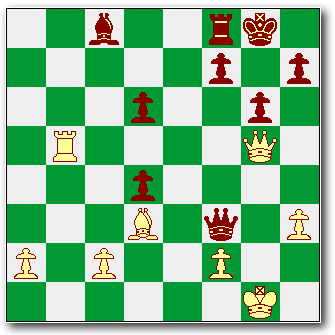
23. ...Bxh3
Ty: My original plan of Qg2++ (under Bh3's protection) is now foiled by the White's Queen on g5. I'm hardly one to pass up the opportunity to take a free pawn, though.
24. Kh2
Al: I really like this move; If Black isn't careful not only will we trade Queens, but I'll take the Bishop for nothing.
Ty: I must have analyzed dozens of different possible moves for White prior to move 24, and I confess that not once did Kh2 ever occur to me. Now if Black plays Qxf2+ then Kxh3, and I'll be out a Bishop.
24. ... Bf1?
Al: Nice move, one I hadn't planned on him to make.
Ty: White can't play Bxf1 because of Qxf2+ followed by Qxf1. I'll bet I spent over an hour analyzing the possibilities before I played Bf1. The pressure was becoming rather intense.
Update by Ty: In re-analyzing this game, I came to the startling discovery that my previous analysis regarding 24. ... Bf1 was totally off the mark. Not only can White play a Bxf1, but if White does it correctly, I'm out a Bishop. Check this out:
24. ... Bf1
25. Bxf1 Qxf2+
26. Qg2!
Obviously at minimum I'm out a Bishop. So it looks as if my "nice move" isn't nearly as nice as either Al or I thought it was, and I can only be thankful that we both missed it at the time. As I mentioned, the stress factor at this point in the game was very high, which is probably as good an excuse as one can find in chess. Given the board situation at the time, this set of moves probably would've changed the outcome of the game.
25. Qg3 Qxg3+
26. Kxg3
Ty: White opts to trade out Queens and end the pressure on his beleaguered King. My analysis showed this as the best move available, but I was utterly petrified that Al would prove me wrong.
26. ... Bxd3
Ty: The unprotected Bishop certainly can't stay where he is, and a trade at this point is worthwhile. White's lack of pawn structure leaves him a tough end game.
27. cxd3 Ra8
Ty: At this point my big concern was the pawn on a2. If I were somehow forced to trade off Rooks, I was worried about my King's ability to stop a pawn promotion on the a-file.
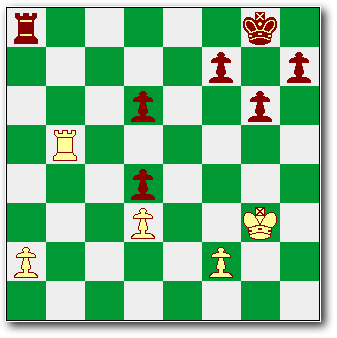
28. Rb2
Al: Probably a mistake; I was still thinking about Queening and a possible win when I should have gone pawn hunting and went for a draw.
Ty: This was somewhat unexpected as I thought Rd5 looked more appealing. (It isn't, by the way.) Barring a serious blunder, my analysis at this point showed this game as a victory for Black.
28. ... Ra3
29. Kf3 Rxd3+
Ty: The poor Rook on b2 faces a heck of a dilemma since he can only protect either a2 or d3. He opts for a2 which gives him a better chance at promotion since the middle is clogged.
30. Ke2
Ty: Personally, I like Ke4 here which keeps King free to go on the attack.
30. ... Ra3
31. Rb8+ Kg7
Ty: Al's famous "spite check." My "spite response" was that I wanted to move there anyway. =)
32. Rb2 Kf6
33. Kd1 d3
34. Kc1 Ke5
35. f3 Kf4
36. Rb3
Ty: White forces either a trade of Rooks or a trade of pawns. After counting the moves to make sure my King could still stop any pawn promotion, I decided on Rooks.
36. ...Rxb3
Al: The move I would have made, although I was hoping he'd trade pawns. White's position is hopeless.
37. axb3 Kxf3
38. Kd2 Ke4
Ty: By sliding across the fourth rank the Black King can simultaneously protect d3 and move toward capturing the remaining White pawn. Ultimately, it's a trade of pawns, but that leaves Black's four pawns and King standing against a very lonely White King.
0-1 White resigns.
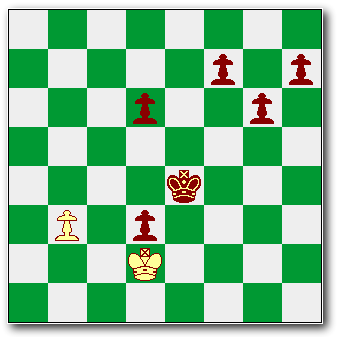
Ty: A well-played game by both sides. White lost ultimately on pawn structure, which is really to say by the narrowest of margins.
|





